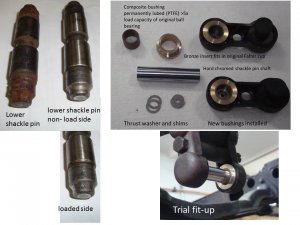- Home
- About Us
- Join/Renew
- Member Benefits
- Member Pages
- Log In
- Help
- Museum Store
A few pictures of my shackle rebuild if anyone is interested. The first shows one of the lower pins that forced me to build replacements, the second pin is from an upper that is damaged on the load side of the ball bearings, but still serviceable on the other side – so I forced it out and will reinstall upside down to put the load on the good side and reuse the Fafnir ball bearings where they are still serviceable.

Exquisite work.
Looks very nice. My only comment is I prefer using bearings to bushings. There are a bunch of diffrent ways to repair the shackle pins. Your factory pins look much better than most I have seen. Cislak still sells the kits for each style from 29 to 38. If I remember correctly there are three diffrent kits. Installing these makes the car drive and track so much better. It’s amazing how few cars have had new pins installed. The only difficult part is pushing the pins in and out as they can be stuck from 75 years of rust and dirt. Also, there isn’t always a lot of room to work under the car to push them out. The local Rolls Royce collector was very impressed with the bearings on the Pierce as his P1 had bushings. Thanks for posting, I wish more members would share their Pierce repairs and restoration. My best, Ed.
Yes, getting that better upper pin out (I mislabeled as a lower)was a bear, took most of the day to cobble together a one-off puller to get it out, and when it finally started it did so with a bang! Now I get to try to put it back in without damaging. I considered replacing with needles or Timken rollers, but after reviewing the PASB methods to get the original Fafnir cups out by grinding and chiseling – that looked like more potential for damage than gain, and would have had less load capacity. The brass fittings use the original cup without trying to force them out. Also, having spent entirely too much time thinking about it, my theory for why the aft lowers failed way before the rest is that they are the ones subjected to the most water/salt/dirt kicked up by the wheel. I was surprised that there could be so much rust inside the bearing with no evidence of it below on the outside of the shackle. I think the rubberized washers on the sides managed to let water creep in while the car was bouncing around in the winter, then kept it trapped in the bearing. The PTFE lubed composite bushings can get wet and still work without damage. If I were to do it again, I might substitute stainless shafts for chrome plate to avoid corrosion on the pin ends, but of course all of this is gilding the lily given how little the car will be driven. However, I did end up driving my 36 Packard 300 miles through the rain to a meet this summer, but that car has an automatic Bijur constantly pushing a little oil through them. I think the main thing to get it to handle properly should be installing with near zero clearance axial and radial. The difference in resistance to shackle turning due to the somewhat higher friction of the composite bushing compared to a ball bearing I calculate is well less than 1%. The variability of the spring interleaf slippage is probably greater than that. That’s my theory anyway, and I am sticking to it!
At any rate, I will still have 5 out of 7 on the original balls.
Thanks,
Jim
Thanks for the update Jim. There are always more than one way to correctly repair a car, it’s always interesting to see what others come up with for ideas. How about a few more photos of your car.
